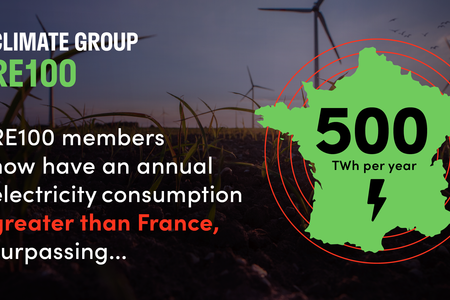RE100 brings together over 340 of the world’s most influential companies, committed to using 100% renewable electricity across their global operations.
By the end of 2020, 65 RE100 companies were reporting over 90% renewables use, and 53 had announced reaching 100%. These are fantastic achievements, but it’s not the end of the journey. What happens after a company achieves 100%? What happens if a company is unable to achieve 100% by its target date? And is 100% a ‘fair’ measure of leadership given that it’s more difficult to achieve in some markets?
In this blog, Sam Kimmins, Head of RE100, and Guste Saduikyte, RE100 Engagement Manager, explore some of the key questions from our members and explain why RE100 is more than a CSR box to tick.
How does RE100 drive change? Individual leadership, and collaborative movement for change
RE100 creates change through the individual leadership of our members, and through their collective ambition and action.
Individually, RE100 companies are investing in renewables at scale with MW and GW scale Power Purchase Agreements (PPA) deals announced on an almost daily basis. To achieve their RE100 target, members must source 100% RE in every market in which they operate – whether that be in mature markets like California or more challenging markets like Korea. 100% leaves no room for doubt – and our members are rightly recognised as leaders in the renewable electricity transition.
RE100 also operates as a collective movement for change, and this is where we really scale up our impact. With combined electricity demand exceeding that of the UK (over 350TWh/yr), RE100 members represent a powerful demand signal for governments and regulators to open up their markets to investment in renewables.
This demand signal is being heard. President Tsai of the Taiwanese Authorities remarked in her 2019 Industrial Policy keynote, that “The Ability for companies to achieve RE100 is a critical consideration for industrial policy”. Recently the Korean government introduced what they have dubbed ‘RE100 policies’, recognising the increasing demand from both international and local businesses to access low cost, clean renewable electricity, in a fair and credible market.
Both individual commitment, and collective action are important. Our voice in the international policy arena would not be credible without the individual actions of RE100 to source renewables and meet their RE100 goals in a credible way (as defined by RE100’s Technical Criteria). By acting together, RE100 companies are not only opening markets for themselves, but they are also spearheading a movement that is making renewables accessible to all and driving change towards 100% clean grids.
How quickly should a company aim to achieve its RE100 target?
We encourage RE100 members to set ambitious targets commensurate with the urgency of climate action, however the date at which companies can be expected to achieve their RE100 target varies depending on where they operate. Companies with operations restricted to mature markets like the UK should be able to achieve RE100 with relative ease, while peers with significant operations in more challenging markets face a much longer-term challenge.
Other factors also influence when a company will reach 100%. For example, some members have a policy of only purchasing using ‘direct’ methods, such as self-generation or PPAs. This involves longer lead times, (and sometimes a long wait if direct sourcing is not yet available in a market) but has a strong direct impact of adding renewable generation capacity. Other members are focussing on direct policy advocacy, working with our RE100 Policy Working Groups to open up sourcing options in a market, before making longer term investments. These practices are important in achieving the broader change we want to create together, and we recognise that setting a later RE100 target date can be a worthwhile trade-off.
So, while achieving 100% is a central pillar of RE100, leadership is about how we use that goal to drive market change, and less about racing a competitor to be first to reach 100%.
Impact beyond the RE100 target
Making progress towards its RE100 target is a major achievement for a company, as well as an important proof-point for the campaign, demonstrating that our members are serious about their commitment. We are proud to publicly celebrate the growing number of members who have reached 100%
Nevertheless, RE100 is not a CSR tick box exercise – together we’re making significant progress to open markets to corporate sourcing around the world, in the drive towards renewable grids.
Being part of RE100 is about supporting the collective aim to accelerate progress towards clean energy – achieving 100% is only one aspect of this. Our members bring valuable experience in renewable electricity sources that allows us to successfully shape our policy engagement. RE100 members are also pioneering practices that go beyond their RE100 target, such as engaging supply chains to become 100%, working with landlords to make it easier for tenants to switch to 100% renewables, or driving towards 24/7 renewables. We discuss different aspects of leadership in more detail in our Business Leadership paper.
As markets develop, and corporate sourcing becomes more sophisticated, the definitions of leadership are shifting. In mature markets, the 24/7 renewables initiatives led by CEBA and RESource are an exciting exploration into the creation of fully renewable operations. At the same time we must also not forget that there are markets where it’s still not possible to source renewables at scale. Balancing both of these aspect of leadership is vital, to avoid a disparity where companies are sourcing 100% renewables 24/7 in the US, while their operations in Asia or Africa remain connected to fossil-fired grids with no meaningful access to renewables.
In practical terms, when a company achieves its 100% goal, it’s required to report to CDP to verify that its data is robust and the claim is in accordance with RE100 criteria. We publicly celebrate verified 100% claims, with the full list of companies achieving 100% shown in the RE100 Progress and Insights Report
What happens if a company drops below 100%?
Once a company reaches 100% or gets close to the target, maintaining this achievement can be challenging. Acquisition of new subsidiaries, expansion into new markets, or negative changes in previously open markets such as Mexico, can sometimes result in a company dropping below 100%.
We encourage companies to be transparent when this happens, as it helps other members to identify challenges, and helps the RE100 team to identify difficult markets where policy action may be required.
It’s also important for members to manage expectations of shareholders and other key stakeholders in these circumstances.
Usually the drop is just a few percent, and 95% is still great if a company is making best efforts to support the mission of RE100 and keeping an eye on opportunities to get back to 100%. Sometimes, however, this dip is neither short-term nor small – for example if Mexico remains on its current trajectory it may be many years before companies are able to source renewables in that market. A large drop caused by factors beyond a company’s control may be more challenging to communicate and we encourage companies to get in touch with us should they anticipate this happening to align messaging and share learning across the group.
Companies approaching or achieving 100% are also encouraged to look at ways to improve how they source renewables. For example, there is a growing trend within the RE100 membership, to shift from claiming renewables use through unbundled certificates (which represent a year-on-year cost) to PPAs, self-generation, or other measures that have a more direct impact and in the right market conditions can yield cost savings. Making these shifts can not only increase a company’s overall impact and improve the bottom line, they also send an important market signal.
What happens if a company doesn’t reach 100% by their target date?
100% is intentionally challenging. As such we expect companies to experience unexpected barriers, and that many will not quite reach that elusive 100% by their target date.
A condition of membership is that companies take concrete action to progress towards their RE100 target. Nevertheless, setting an RE100 target involves an element of risk, with variables beyond a company’s control, such as when markets will introduce policies to enable corporate sourcing. For example, while we expect the Korean and Japanese markets to be open to PPAs in the next year or so (2022-23), this is not guaranteed. For some markets, we have no indication of when the market will open. Sometimes a market will become more challenging – for example Mexico, where current government policy is acting to reduce options for corporate investment in renewables. We recognise that this will impact on some of our member’s ability to reach 100% by their target date and may require some revision of those dates.
Critically, we ask RE100 members to be transparent about where they are facing challenges. The last few percentage points are generally the most challenging and most expensive. While it is important for these barriers to be addressed in the long term, 80%, 90% renewable is still highly respectable, and we encourage members to consider focusing on policy and other routes to impact should they get stuck. Leadership is not always be about rushing to ‘tick the box’ of 100%.
A company may even voluntarily decide to extend their RE100 target date following a shift in their strategy to invest in on-site renewables, move away from unbundled RECs, or to focus their efforts on our Policy Working Groups to open up challenging markets. The important factor is that this is presented transparently and undertaken with a clear aim of driving change towards zero carbon grids.
We cover the issue of transparency in more detail in our Making Transparent RE100 claims document.
Leadership is explored in our Business Leadership paper
Our Policy Messages can be found here



